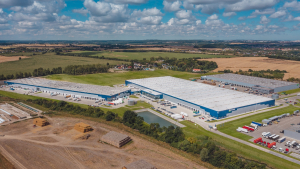
More than 600,000 sqm of warehouse space is under construction in Lower Silesia. Of that total, nearly two-thirds are being built in Wrocław and its suburbs. Demand for new warehouses in the region comes mainly from e-commerce and 3PL, according to Newmark Polska.
With close to 3.15 million sqm, or over 12 percent of Poland’s total industrial stock, Lower Silesia is the country’s fourth largest warehouse market. Robust developer activity and strong occupier demand are testaments to the draw of the region.
65 percent of warehouse space for e-commerce and 3PL
Like in the rest of Poland, Lower Silesia also reported buoyant leasing activity last year, with warehouse and industrial take-up hitting a record high of over one million sqm, which represented an almost 100% increase on the 2016-2020 annual average deal volumes. According to Newmark Polska, the first quarter of this year saw another 75,000 sqm of leasing transactions.
“Lower Silesia’s modest take-up volume in the first three months of this year is attributable to the limited availability of large units of over 10,000 sqm in existing warehouses while for a new space tenants have to wait. In addition, the war in Ukraine and the increasingly serious supply chain disruptions have pushed construction costs up, indirectly driving rental growth, which has led to longer project development and negotiation times,” says Agnieszka Giermakowska, Research & Advisory Director, Newmark Polska.
Occupier activity in the region was recently driven by e-commerce and 3PL, which accounted for 65 percent of the total take-up in 2021.
“Due to warehouse rental growth, some tenants have mothballed relocation plans and instead chose to stay on in their current warehouses for some time. As a result, regearing is on the rise, with renewals accounting for 40 percent of all deals in the region, a marked increase from 10% in the first quarter of 2021,” says Anna Domańska, Advisor, Industrial and Warehouse Department, Newmark Polska. “Lease renewal negotiations are expected to be a notable trend throughout Poland due to not only rising occupancy costs but also fewer projects breaking ground. That being said, continuing in your current location is also likely to be sometimes more economical.”
Wrocław accounts for two-thirds of the warehouse development pipeline
At the end of the first quarter of this year, warehouse availability in Lower Silesia stood at just under 100,000 sqm, equating to a relatively low vacancy rate of 3.2 percent. This represents a 0.5 pp increase on the fourth quarter, but a marked decrease of 4 pp year-on-year, says Newmark Polska. “In addition, available warehouse space is dispersed across the region, with only three industrial complexes offering units of 10,000 sqm or more. It will take some time before tenants have more options to choose from in Lower Silesia. At the end of the first quarter of this year, the region’s development under construction comprised close to 632,000 sqm of modern warehouse and industrial space, of which 61 percent was available for lease. Most projects underway are expected to be completed in the second half of this year, while some are scheduled for delivery in early 2023,” comments Agnieszka Giermakowska. “Wrocław and its suburbs account for close to two-thirds of the warehouse development pipeline in Lower Silesia. Developer activity is also underway in Wałbrzych, Jelenia Góra, Legnica, Bolesławiec and Zgorzelec.”
There is still space for new investors
According to Tomasz Kowalski, Director, Hays Poland, the location of a manufacturing plant or a warehouse can greatly affect the ability to attract employees. “The closer facilities are to large cities such as Wrocław and Wałbrzych, the easier the access to candidate pools. Building a team is, however, likely to be challenging in borderland areas as many living within a 20-30 km radius from the border would rather choose better-paid jobs in Germany or even the Czech Republic,” says the expert. “Despite being saturated, the Lower Silesian labour market still offers new investors plenty of opportunities. They are recognized by international corporations which are increasingly considering Poland as a potential location for nearshoring projects. Attracting employees to work in warehouses and factories also largely depends on the size of the warehousing and manufacturing facility. If you’re planning to hire up to a hundred people, a competitive pay package will help you get the right staff. Employment strategies for larger plants, however, will require inclusion of a foreign workforce and frequently also the provision of free, daily commutes.”
Tomasz Kowalski says that the strongest demand is for grey-collar workers, or a skilled manufacturing workforce, who have learned a trade but are not necessarily engineers. They include welders, mechanics, electricians and electrical mechanics. Recruitment for these jobs is currently the biggest challenge due to the shortage of such employees in the labour market.
Developers flock to Lower Silesia
Both local and international developers have built a presence in the Lower Silesian industrial and warehouse market. Development activity in the region is led by Panattoni, Hillwood and GLP.
“One of the most interesting developments announced in the province is the joint project of Hillwood Polska and Develia in Malin. It will be developed in four phases, at least, and provide a minimum of 400,000 sqm to the market, and is expected to be the region’s biggest logistics park. Another recent announcement came from P3, which is planning to build nearly 175,000 sqm of warehouse space in Kąty Wrocławskie,” says Anna Domańska, Newmark Polska. “June 2022 saw the completion of the first building of GLP Wrocław V Logistics Centre. Construction works have already commenced on another 41,000 sqm building and the whole project developed by GLP is scheduled to deliver 230,000 sqm at full build-out. At the same time, extensions are underway at existing industrial parks, including Panattoni Wrocław Campus 39 (another 44,500 sqm is to be added) and Panattoni Park Wrocław West Gate (plus another 30,000 sqm). Additionally, Panattoni announced a new project in Lower Silesia in Magnice – Wrocław Logistics South Hub with a total area of 247,000 sqm. In the first stage, the developer will build 120,000 sqm of space.”
Land for new projects and extensions in the region has also been secured by 7R, DL Invest, LCube, PROPCO, and MLP Group.



